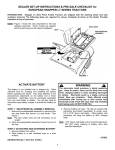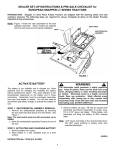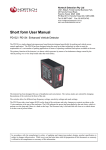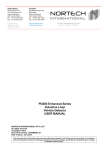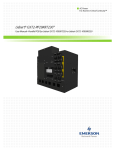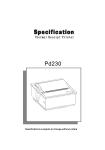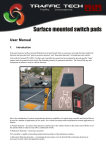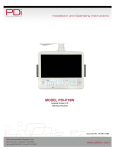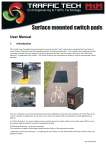Download Short form User Manual
Transcript
Nortech Detection Pty Ltd Unit1, Bldg 5, Forest Central Business Park, 49 Frenchs Forest Road, Frenchs Forest NSW 2086 PO Box 6011, Frenchs Forest DC, NSW 2086 Tel: 02 8977 4047 Fax: 02 9475 4742 email: [email protected] web: www.nortechdetection.com.au Short form User Manual PD232 / PD234 Enhanced Vehicle Detector The PD232 / 234 is a dual channel microprocessor based detector designed specifically for parking and vehicle access control applications. The PD232 / 234 has been designed using the latest technology in order to meet the requirements of diverse parking applications in terms of operating conditions. A number of internal functional options are available to the user. The primary function of the detector is to detect vehicle presence by means of an inductance change caused by the vehicle passing over a wire loop buried under the road surface. The detector is part of a general purpose product range which includes the popular PD130 series of single channel detectors for ease of installation and convenience. Various operating modes are selected by changing the position of switches on the front of the unit and internal jumper selection. The detector oscillator is multiplexed to eliminate any possibility of crosstalk between the loops connected to the detector. The switches allow for different loop frequency settings, sensitivity settings and mode settings. The unit has a number of internally selectable options for configuration of the relay outputs. The PD232 / 234 provides visual outputs (LED) on the front of the enclosure and output relay contacts at the 11 pin connector at the rear of the enclosure. The power LED indicates that the unit has been powered. The channel status LED’s below indicate that a vehicle is present over the loop and when there is a fault on the loop. The Presence relays are normally fail-safe and will close on a vehicle detect, loop failure or in the event of a power failure. In accordance with the manufacturer’s policy of updating and improving product designs, product specification is subject to change without notice. While every care has been taken with the preparation of this document, no warranty is offered to the completeness or accuracy of this information. PD232 /PD234 Enhanced Vehicle Detector – User Instructions Page 2 of 9 1. Operating Instructions 1.1. Switch Setting Selections 1.1.1. Frequency Switch The frequency switches are the lower two switches, numbered 1 and 2. There are four frequency selections and are set out as follows: SW2 SW1 Off Off High On Off Medium-High Off On Medium-Low On On Low The frequency switches allow the loop frequency to be shifted higher or lower depending on the switch position. The frequency of the loop is determined by the loop size, and the frequency of the switch simply causes a frequency shift on the loop. Where more than one detector is used the detectors must be set-up to ensure that there is no cross-talk (interference) between the detectors. This can be achieved by ensuring that the loops of the two detectors are spaced sufficiently apart (approximately 2 meters between adjacent edges) and also ensuring that the detectors are set to different frequencies. As a general rule, the detector connected to the inductive loop with the greatest inductance should be set to operate at the lowest frequency. Loop inductance increases as loop size, number of turns in the loop and feeder length increases. When the switch selection is altered, the frequency on both loops will change as the unit is multiplexed and therefore use a common oscillator. There is no possibility of interference between the loops connected to a single dual channel detector owing to the multiplexing function. 1.1.2. Sensitivity Switch The sensitivity of the detector allows the detector to be selective as to the change of inductance necessary to produce an output. There are four sensitivity selections and are set as follows: CH1 CH2 SW6 SW4 Off On Off On SW5 SW3 Off Off On On - High Medium-High Medium-Low Low 1.1.3. Automatic Sensitivity Boost Automatic sensitivity boost is a mode that alters the “undetect” level of the detector. switch No. 7 on the front of the enclosure and is as follows: SW7 Off On - Disabled Enabled This mode is selected by PD232 /PD234 Enhanced Vehicle Detector – User Instructions Page 3 of 9 Automatic sensitivity boost causes the sensitivity to be boosted to a maximum on detection of a vehicle, and maintained at this level during the presence of the entire vehicle over the loop. When the vehicle departs the loop and the detection is lost the sensitivity reverts to the pre-selected level. 1.1.4. Presence Time The presence time may be set to permanent presence or to limited presence. In permanent presence mode the detector will continuously compensate for all environmental changes whilst there is a vehicle present over the loop. In limited presence mode there will be a finite time that the detector will remain in detect. This time is dependent on the change of inductance that the vehicle caused. The presence mode is set with switch No. 8 and is configured as follows: SW8 Off On - Limited Presence Permanent Presence 1.1.5. Pulse / Presence selection The channel’s relay may be set to either Pulse Mode or Presence Mode Presence mode provides a continuous output for the duration of the vehicle presence (subject to presence time setting). Pulse or presence mode is set with switches No. 9 & No.10 as shown in the table below: CH1 SW10 Off On CH2 SW9 Off On - Presence Pulse 1.1.6. Reset Switch The detector automatically tunes to the inductive loop connected to it when the power is applied, whether on initial installation or after any break in power supply. Should it be necessary to re-tune the detector, as may be required after changing any of the switches or after moving the detector from one installation to another, momentary operation of the RESET switch will initiate the automatic tuning cycle. PD232 /PD234 Enhanced Vehicle Detector – User Instructions Page 4 of 9 1.2. Internal Link Selection There are one 3 way link located inside the PD230 that is used to configure the AB Logic options. This link has been placed inside the unit to avoid incorrect operation due to selection by unauthorised persons. The internal link selections are illustrated in the following diagram. For a description of the AB Logic mode refer to section 2 - “Modes of Operation” 1.3. Front Panel Indicators While the detector is tuning, the Channel LED will indicate the “mode” status of the detector. i) Any Channel output operating in the presence or pulse modes will come on and extinguish when the system is tuned. ii) When the AB Logic mode is selected, the Channel LEDs will alternatively flash slow and extinguish when the system is tuned. If a loop fault exists the Channel LED will come on and flash indicating a fault. If the fault is self-healing the detector will continue to operate and the LED will continue to show the historical fault. The detector must be reset or power removed to clear the historical fault information. The channel LED will also glow whenever a vehicle is detected passing over the inductive loop. The Power LED at the top of the unit will remain on to indicate that the unit is powered. This LED is also used as the link to the diagnostic unit ( DU100 ). PD232 /PD234 Enhanced Vehicle Detector – User Instructions Page 5 of 9 2. Modes of Operation 2.1. Presence Mode In the presence mode the detector will give a continuous output during the presence of a vehicle over the inductive loop. As the detector is designed with the permanent presence feature, the detector will indicate vehicle presence for an unlimited period of time. If the permanent presence is not selected, then the detect time will be dependent on the change of inductance. The presence time on the limited presence setting will be approximately 1 hour for 3% ∆ L/L. 2.2. Pulse Mode When the relay is in a pulse output configuration it will output a pulse of 150 or 250 millisecond duration when the vehicle enters the loop area. 2.3. A-B Logic Mode In this mode the detector is used as a direction sensor and the primary task is to indicate the direction of travel over the loops. To achieve this two loops are placed in a manner to ensure that a vehicle passes over them in sequence A ⇒ B when traveling in one direction and in reverse order B ⇒ A when travelling in the opposite direction. In this mode the CH1 relay provides an output when vehicles travel in the direction A ⇒ B and the CH2 relay provides an output when vehicles travel in the direction B ⇒ A. The “direction” output may be a “presence” or “pulse” output. The presence output is available from the time that the vehicle reaches the front edge of the second loop in the direction of travel until the vehicle vacates the second loop. The pulse output occurs at the time the vehicle departs the first loop in the direction of travel having occupied both loops in the correct sequence. If the vehicle backs out while still over the second loop a further pulse is issued on the relay for the other direction, maintaining count accuracy. Note that for correct operation of the direction logic, the space between the loops must be less than the length of the shortest vehicle to be detected. The minimum distance separating the loops should be 1 metre if the vehicle speed will be greater than 15km/H. 3. Technical Specification Self-tuning range 20 to 1500µH Sensitivity Four step switch selectable: High 0.02% Δ L/L Medium High 0.05% Δ L/L Medium Low 0.10% Δ L/L Low 0.50% Δ L/L Outputs Output relays may operate in the Presence ( fail-safe ), Pulse or Direction logic modes Pulse Output Duration 150/250 millisecond options Response Times 100 milliseconds Drift Compensation Rate Approx. 1% Δ L/L per minute Relay Rating 5A @ 230VAC Surge protection Loop isolation transformer, gas discharge tubes, and Zener diode clamping on loop input PD232 /PD234 Enhanced Vehicle Detector – User Instructions Page 6 of 9 4. Power requirements 12 - 24V AC/DC (PD234) 230V AC ±15 % ( 48 to 60Hz ) Requirement: 1.5 VA Maximum @ 230V Operating Temperature -40°C to +80°C Mounting Position Shelf or DIN rail mounting Connections 11-pin submagnal type (JEDEC No. B11-88) Size of Housing 78mm (H) X 41mm (W) X 80mm (D) Wiring Connections 11 PIN CONNECTOR WIRING CODE ( BEIGE ) PIN COLOUR DESIGNATION 1 2 3 4 5 6 7 8 9 10 11 Red Black Blue Blue Yellow Yellow Grey Grey Green/Yellow White White Live Neutral Channel 1 loop Channel 1 loop Channel 2 loop Channel 2 loop Channel 2 N/O relay contacts Earth Channel 1 N/O relay contacts 230V AC 50/60 Hz OR 12 - 24V AC/DC Twist this pair Twist this pair PD232 /PD234 Enhanced Vehicle Detector – User Instructions Page 7 of 9 5. Installation Guide Optimum functioning of the detector module is largely dependent on factors associated with the inductive sensor loop connected to it. These factors include choice of material, loop configuration and correct installation practice. A successful inductive loop vehicle detection system can be achieved bearing the following constraints in mind, and strictly following the installation instructions. The detector must be installed in a convenient weatherproof location as close as possible to the loop. 5.1. Operational Constraints 5.1.1. Crosstalk When two loop configurations are in close proximity, the magnetic fields of one can overlap and disturb the field of the other. This phenomenon, known as crosstalk, can cause false detects and detector lock-up. Crosstalk between adjacent loops operating from different detector modules can be eliminated by: 1. Careful choice of operating frequency. The closer together the two loops, the further apart the frequencies of operation must be. 2. Separation between adjacent loops. Where possible a minimum spacing of 2 metres between loops should be adhered to. 3. Careful screening of feeder cables if they are routed together with other electric cables. The screen must be earthed at the detector end only. NOTE DUAL CHANNEL DETECTORS ELIMINATE CROSSTALK WHEN TWO LOOPS ARE CONNECTED TO THE SAME DETECTOR. ADJUSTMENT TO OPERATING FREQUENCY AND LOOP SEPARATION REQUIREMENTS DO NOT APPLY UNLESS MORE THAN ONE DETECTOR MODULE IS INSTALLED 5.1.2. Reinforcing The existence of reinforced steel below the road surface has the effect of reducing the inductance, and therefore the sensitivity, of the loop detection system. Hence, where reinforcing exists 2 turns should be added to the normal loop, as referred to in section 5.3. The ideal minimum spacing between the loop and the cable and steel reinforcing is 150mm, although this is not always practically possible. The slot depth should be kept as shallow as possible, taking care that the feeder remains exposed after the sealing compound has been applied. WARNING : Cutting into post tensioned concrete slabs can have catastrophic consequences. As a general rule 30mm is the deepest slot depth allowable in such cases. When any doubt exists the structural engineer’s approval must be sought prior to commencement. 5.2. Loop and Feeder Specification The loop and feeder should preferably constitute a single unjoined length of insulated copper conductor, with a minimum rating 15Amp. Joints in the loop or feeder are not recommended. Where this is not possible, joints are to be soldered and terminated in a waterproof junction box. This is extremely important for reliable detector performance. PD232 /PD234 Enhanced Vehicle Detector – User Instructions Page 8 of 9 5.3. Sensing Loop Geometry Sensing loops should, unless site conditions prohibit, be rectangular in shape and should normally be installed with the longest sides at right angle to the direction of traffic movement. These sides should ideally be 1 metre apart. The length of the loop will be determined by the width of the roadway to be monitored. The loop should reach to within 300mm of each edge of the roadway. In general, loops having a circumference measurement in excess of 10 metres should be installed using two turns of wire, while loops of less than 10 metres in circumference, should have three turns or more. Loops having a circumference measurement less than 6 metre should have four turns. It is good practice at time of installation to construct adjacent loops with alternate three and four turn windings. 6. Loop Installation All permanent loop installations should be installed in the roadway by cutting slots with a masonry cutting disc or similar devise. A 45° crosscut should be made across the loop corners to reduce the chance of damage that can be caused to the loop at right angle corners. NOMINAL SLOT WIDTH: 45mm NOMINAL SLOT DEPTH : 30mm TO 50mm A slot must also be cut from the loop circumference at one corner of the loop to the roadway edge to accommodate the feeder. A continuous loop and feeder is obtained by leaving a tail long enough o reach the detector before inserting the cable into the loop slot. Once the required number of turns of wire is wound into the slot around the loop circumference, the wire is routed again via the feeder slot to the roadway edge. A similar length is allowed to reach the detector and these two free ends are twisted together to ensure they remain in close proximity to one another (minimum 20 turns per metre). Maximum recommended feeder length is 100 metres. It should be noted that the loop sensitivity decreases as the feeder length increases, so ideally the feeder cable should be kept as short as possible. The loops are sealed using “quick-set” black epoxy compound or hot bitumen mastic to blend with the roadway surface. Figure 1 Slot details PD232 /PD234 Enhanced Vehicle Detector – User Instructions Page 9 of 9 Note: Loop separation requirements do not apply if both loops are connected to a dual channel detector. In this case there are no restrictions Figure 2 Adjacent loops connected to different detector modules









